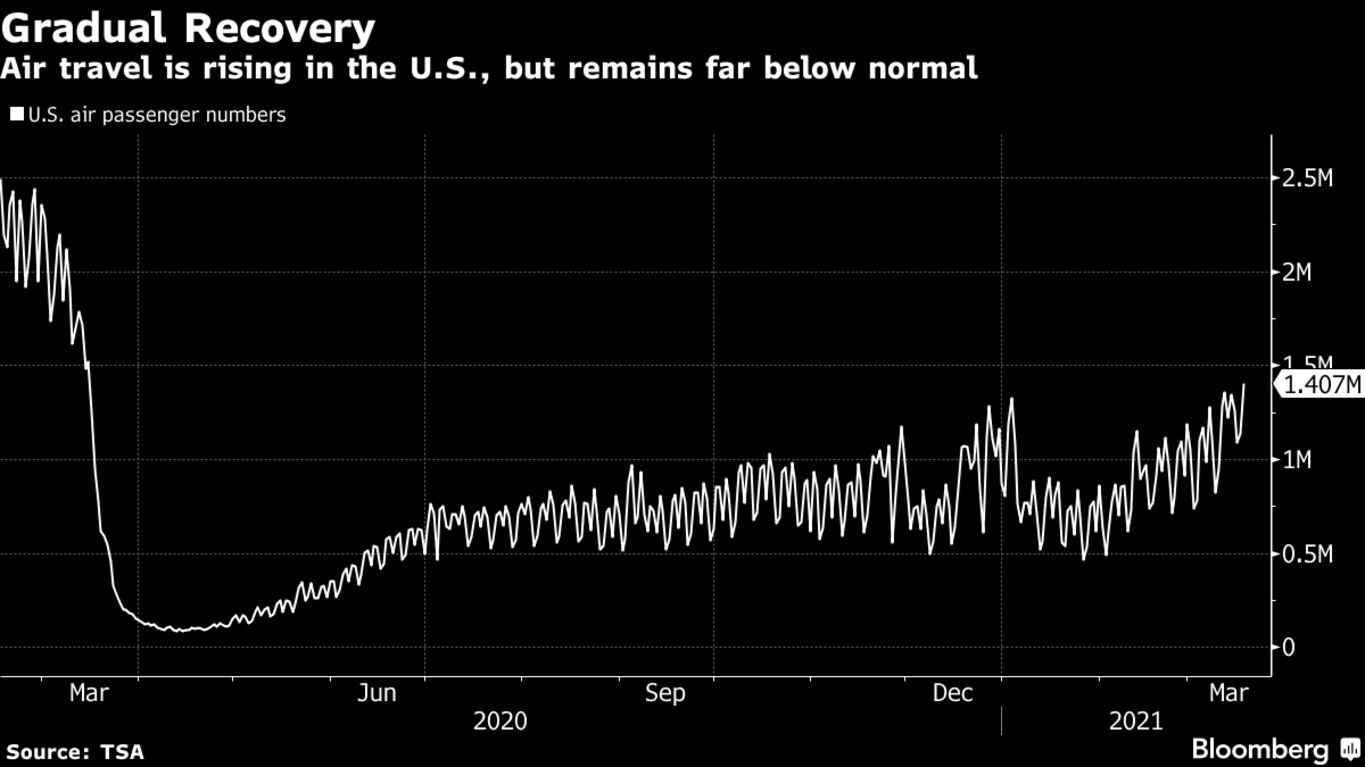Oil just experienced its biggest one-day price slump in more than six months, but it hasn’t veered off the road to recovery. Even as problems with Europe’s vaccine program and a slowdown in Chinese crude buying sent futures down 7% on Thursday, data from around the world showed a steady, albeit patchy, recovery in demand. A year ago, idled jetliners were parked wing-tip to wing-tip on airport taxiways as a raging virus kept billions of people at home. Today, U.S. airports are the busiest since the pandemic started and flight attendants are returning from furlough.
These steps back toward normality from one of the industries hit hardest by Covid-19 is just one of many signs that the world is starting to move again. Consumption of gasoline, diesel and jet fuel are at the highest in more than a year.
The market’s jitters may still be justified. A renewed lockdown in Italy showed that any gains can be quickly lost if the spread of the virus accelerates again. Similarly, Germany’s restrictions may be extended by another four weeks after Covid-19 cases rose. Yet things are likely to keep improving through the summer, traditionally the peak period for oil demand.
“Western world oil demand looks set to bounce on the back of the economic recovery, stimulus, vaccination progress, and easing pandemic measures,” said Norbert Ruecker, head of economics and next-generation research at Julius Baer. “Europe’s vaccination hiccups hardly change the economic outlook.”
Up and Away
Global oil demand, which plunged as much as 30% during the worst of the pandemic lockdowns last March and April, is now back at about 95% of the pre-Covid high of just over 100 million barrels a day hit in 2019, according to the International Energy Agency. Together with aggressive output cuts from the OPEC+ alliance of oil exporters, that’s helped a revival in prices of more than 20% this year — even after Thursday’s slump.
Commercial flights are back at two-thirds of comparable pre-Covid levels, the most activity since air traffic slumped a year ago, according to data from Flightradar24. In the U.S., foot traffic in airports has picked up, with a run of over 1 million daily passengers for eight straight days ending on Thursday — something that hasn’t happened since the pandemic started.

In another indication of renewed optimism about travel, the flow of gasoline and diesel from refineries on the U.S. Gulf Coast to Mexican ports accelerated from February into March as the Latin American country’s resorts prepared for an influx of tourists over spring break, according to shipping data compiled by Bloomberg.
In China, air-passenger volumes climbed to 23.9 million trips in February, nearly three times the level of a year earlier, when the initial stages of the pandemic had grounded most of the country’s jets, according to the local civil aviation administration.
Asian jet fuel demand should see a gradual improvement over the course of 2021, largely driven by domestic flights, said Sri Paravaikkarasu, Asia head of oil at FGE.
But it’s a long road to full recovery for the market. Europe’s air traffic has been higher than forecast, but is still languishing at about a third of pre-pandemic levels,
“Even with the rapid mass distribution of the vaccine, it will require months for borders to fully open,” Paravaikkarasu said. “Given the cautious approach to reinstating international flights, Asia’s jet fuel demand should only recover to pre-pandemic levels by 2023.”
